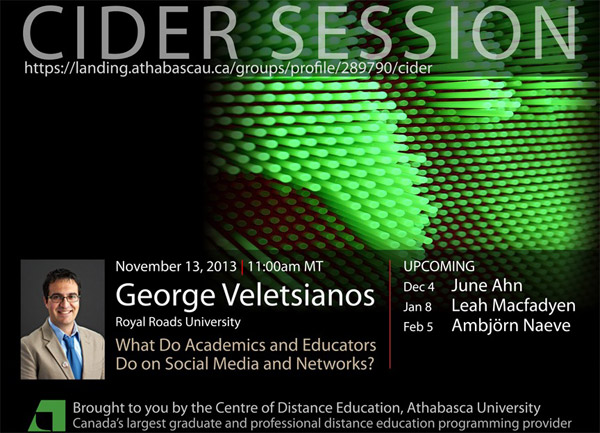I was at the Educause Learning Initiative conference last week (#ELI2014), where I had some interesting conversations and discussions around online learning, MOOCs, research methods, and the future of higher education.
Amy Collier and I presented early results from our qualitative studies looking at learners’ MOOC experiences (if you have not yet responded to our call to share your lived experiences with us, please consider this invitation). Our talk was entitled “Messy Realities: Investigating Learners’ Experiences in MOOCs.” Our thinking is guided by the notion that even though surveys and big data yield insights into general behavioral patterns, these methods are detached and can distance us rather than help us understand the human condition. As a result, the phenomenon of “learning in a MOOC” is understudied and undiscovered. During the session, we shared what we have been finding in our studies, highlighting the messiness of learning and teaching in the open.
Karen Vignare and Amy Collier were also very kind to extend an invitation to a number of us to share our work with individuals participating in the leadership seminar they organized. It was fantastic to hear Katie Vale (Harvard), Matt Meyer (The Pennsylvania State University), Rebecca Petersen (edX, MIT), and D. Christopher Brooks (EDUCAUSE) discuss their work, and once again, I felt grateful that we are having these conversations more openly, more frequently, and with greater intent.
Below are my rough notes from my 5-7 minute presentation. I appreciate parsimony (who doesn’t?), and in the words of D. Christopher Brooks, this is the litany of things I think:
I am a designer and researcher of education and learning. I study emerging technologies and emerging learning environments. I’m also a faculty member , and I have been teaching in higher education settings both face-to-face and online since 2005.
To contextualize my comments on MOOCs, first I want to describe my experiences with them:
– I have facilitated one week of the #change11 MOOC was organized by George Siemens and Stephen Downes in 2011. This MOOC had a distinctively connectivist flavor with each week being facilitated by 1 person.
– I have enrolled in a number of MOOCs, and have even completed a small number of them.
– I have repurposed MOOCs in my own courses. For example, I have asked students to enroll in MOOCs and write about them.
– I have published an e-book with my students, sharing stories of student experiences with MOOCs.
– Finally, I am actively involved in studying learners’ experiences in MOOCs in order to understand the human element in these emerging learning environments.
I have recently come to the realization that I have an ambivalent relationship with MOOCs. My relationship with MOOCs is one of the most ambivalent relationships I have had with anyone or anything. This relationship is more ambivalent than the love-ignore-hate relationship that my cat has with me!
On the one hand, I appreciate the opportunities for open learning that MOOCs provide. I also appreciate how MOOCs have brought us together to discuss issues around technology, teaching, and learning. At the same time, I cringe at the narratives around big data, I cringe at the hype, at the ignorance around what education is and should be about.
I want to talk about two topics today: MOOC research and the MOOC phenomenon.
On MOOC Research
– We don’t know much about MOOCs
– The things that we know about MOOCs are mostly the result of surveys, learning analytics, and big data research
– The existing research and the existing methods that we use are informative, BUT they simply paint an incomplete picture of MOOCs. We should be asking more in-depth questions about learner and instructor experiences in MOOCs
– Qualitative and interpretive research methods can and will help us better understand MOOCs, open learning, and open scholarship
– Descriptions of learner behaviors are helpful, but these descriptions only provide a glimpse and superficial summary of what students experience and what they do in digital learning environments. To give you an example, emerging research suggests that students may be “sampling” courses; a behavior that we don’t frequently see in traditional online courses or traditional face-to-face courses. Nonetheless, “sampling” is not how participants would describe their experiences or the ways they participate MOOCs. To illustrate, consider family-style Mediterranean meals that consist of numerous dishes, where participants sample a wide array of food. If you ask a person to describe this meal, to explain it to someone else, or to simply tell you about the meal, they will likely describe the meal as a feast, they might describe the tahini as lemony, the variety of flavors as intriguing, the whole meal as satisfying. Different people will also describe the meal differently: Tourists might describe the meal as fulfilling, heavy, or even extravagant; locals might describe the same meal as appropriate, or better than or worst than meals that they have had at other restaurants. “Sampling” may be an appropriate descriptor of the act of eating a family-style meal, or exploring a MOOC, but the descriptor does not fully capture the experience of sampling.
On the MOOC as a Phenomenon
MOOCs. The acronym stands for massive, open, online courses. That is not what MOOCs are though. MOOCs are a phenomenon. They represent something larger than a course and should be seen in conjunction to the rebirth and revival of educational technology. They represent symptoms, responses, and failures facing Higher Education. For instance, MOOCs are a response to the increasing costs of Higher Education; represent the belief that the purpose of education is to prepare students for the workforce; represent the belief that technology is the solution to the problems that education is facing; are indicative of scholarly failures; seem to represent the belief that education is a product that can be packaged, automated, and delivered; and, are a response to failures by researchers, designers, administrators, and institutions to develop effective and inspiring solutions to the problems of education (alternatively, they might also represent the failure of existing systems to support creative individuals in enacting change)*.
The MOOC is an acronym that elicits strong feelings: excitement, fear, defiance, uncertainty, hope, contempt…. To address these feelings we have to address the failures of higher education and the underlying causes that have given rise to MOOCs. For this reason, instead of talking about MOOCs at my own institution, I discuss innovations and approaches that I value, including networked scholarship, openness, flexibility, social learning, and the design and development of new technologies.
* NOTE: Rolin Moe and I are working on a paper refining and delineating these. If you have thoughts, concerns, or input on any of these issues, we’d love to hear form you!



